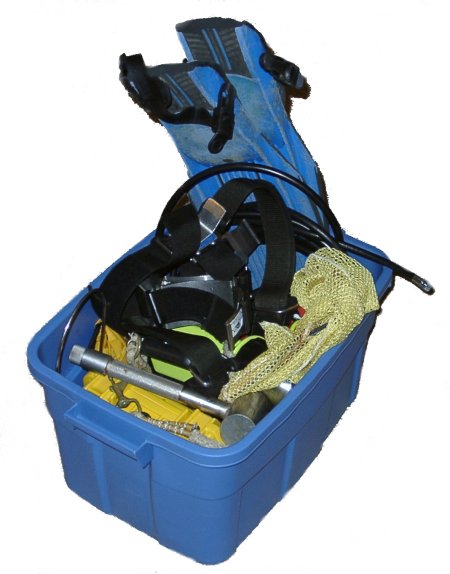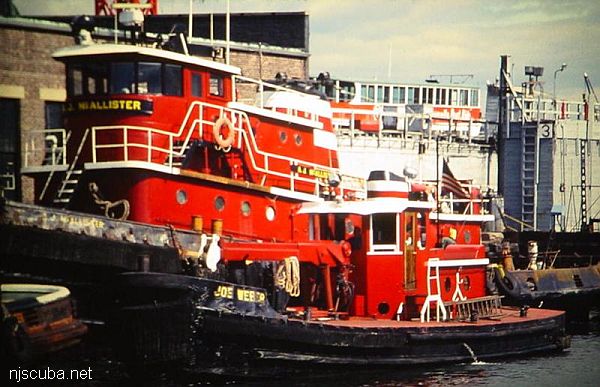Boat Diving
Dive boat operations in the Northeast are significantly different from those you may be used to in the tropics. For this discussion, "Northeast" may be taken to mean any place north of Florida, or south at least to North Carolina.
The typical going rate for boat diving in New Jersey is about $65 for a one-tank excursion, $90-100 for a two-tank excursion. With recent fuel prices, you can expect a small surcharge as well. Longer, deeper, or special trips may cost more. A non-refundable deposit or credit card number is generally required to make the reservation. Once onboard, the crew will do all they can to make your trip a good one, so don't forget that it is customary to leave a tip for them as well - at least $5-$10, more if one of them did something special, like retrieve what you dropped overboard, or save your life. Tips go to the chief mate, not the captain.
Departures are generally in the 7:00 - 8:00 AM range, earlier for offshore trips. You should have all your gear stowed aboard the boat a half-hour before departure. This allows time for paperwork, briefings, and a thorough "idiot-check" to make sure you have everything. The earlier you arrive, the better place you will get. Do not be late or hold the boat up. Time you waste holding up the departure is time you will not be diving if the boat waits for you, which it probably will not. Also, every morning is a race with all the other boats out to the best spots; be late, and you will probably find someone fishing there already. Also, don't count on getting back at the scheduled time - there is no telling what delays may occur out at sea.

As a rule, Northeast dive boats provide transportation only. There will be no gear to rent on the boat, nor are tanks provided, although rentals can often be arranged through a local shop. There may be a few spare weights around the boat if you are a little light, but otherwise, you must have all your own gear, and make sure you brought it with you! Gear should be packed in a compact container as shown above ( $5 at Target. ) On boats with bench seats, your "wet" gear should fit below the bench. Trash cans and towers of milk crates are generally not welcome. And that expensive bag your dive shop sold you - leave it home - nobody uses bags around here. Suits and dry gear can go in the cabin, at least until it is wet. You can use your dive bag for that.
Bare feet are a hazard on and around boats. On a rolling, pitching boat, toes are always in danger - it is very easy to stub, break, or crush one, or rip off a toenail. Bare feet can be extremely slippery on a wet deck, and you can get terrible splinters from a wooden dock. Finally, feet sunburn. Shoes that completely cover your toes, with grippy rubber soles are best, not sandals. You don't need to buy anything special - an old pair of sneakers or even work shoes will work, anything you don't mind getting wet and ruined. I usually sacrifice my oldest pair of shoes every season and throw them away at the end.
Bracelets, rings, necklaces, expensive watches - jewelry has no place on a boat. The only thing you can do is lose it overboard. Rings are especially dangerous - if a ring catches on a screw head or railing when the boat rolls, it can rip your finger off. This is not an old wive's tale, it really happens. So leave all your jewelry back on land. You wouldn't want to take it scuba diving anyway.
Sunburn is a major concern on any boat. On the water, you are catching rays not just directly, but also reflected off the waves, glass surfaces, clouds, and haze. Even in temperate climates, you will burn incredibly fast. Sunscreen is not enough. A wide-brimmed hat ( not a baseball cap ) and a long-sleeved shirt are your best protection. Keep to the shady parts of the boat, and if it has a sundeck, stay the hell off it. A good pair of sunglasses will make your day better as well.
Typically, food will not be provided by the boat. Water is always available, and some boats may provide candy or light snacks, other beverages, and/or cooking facilities ( grill, microwave ) but as a rule, you will be responsible for feeding yourself. And I guarantee that you will be ravenous after emerging from your first dive, so do pack a good lunch. Most boats provide a community cooler and ice that you can use for your lunch, and a game cooler for your catch, so leave your own cooler in the car - nothing fills a boat up faster than a lot of useless coolers. The crew may joke about eating your lunch while you are in the water, but that is not as prevalent as you might think. ( I like chocolate chip cookies myself. )
"Divemastering" as it is known in the tropics is nonexistent in the Northeast. There are no guided tours or hand-holding here. If you are new and need a buddy, one of the crew may consent to take you around, but that is not their job, and you should remember them kindly at tip time. The crew's job is to work the boat: handling docking lines, driving on long runs, hooking up and releasing the wreck, keeping watch, and helping you in and out of the boat, but once you enter the water, you are on your own - there will be no divemaster in the water. Under our conditions, that would not work anyway.
36% Nitrox
It is inconsiderate and inappropriate to bring 36% Nitrox ( "whiner mix" ) on a New Jersey dive boat. 36% is limited to a safe depth of only 95 feet, which severely limits where the boat can go, and northeast weather is far too unpredictable to be hamstrung like this. By rights, if the group wants to go offshore, then the 36-percenter should be told that he is just not diving, but it never works out that way. Instead, every other person on the boat gets detoured to a destination where that one person can dive too. People with more sensible mixes, like 32%, are even more screwed, since they are now wasting their expensive fills inshore when they wanted to go offshore. 36-percenters are often left at the dock if they are caught in time. Do not bring 36% Nitrox on a dive boat unless you are the owner of the boat. Save it for the Caribbean.

